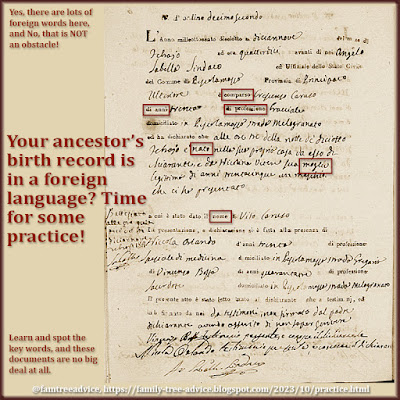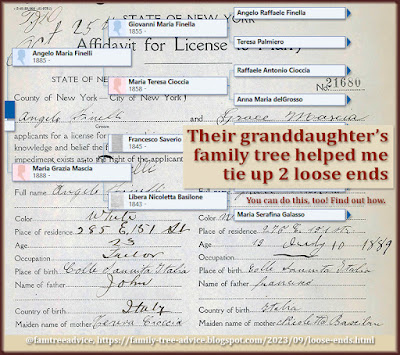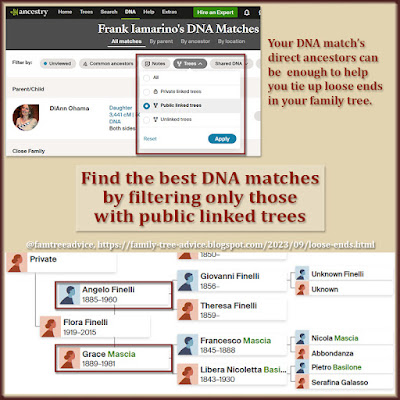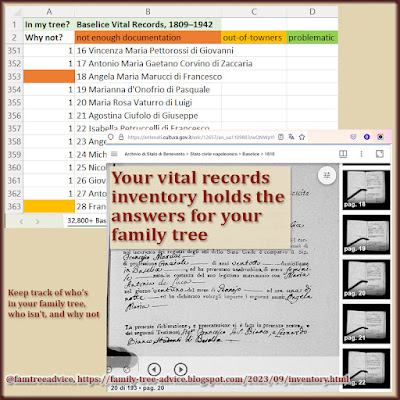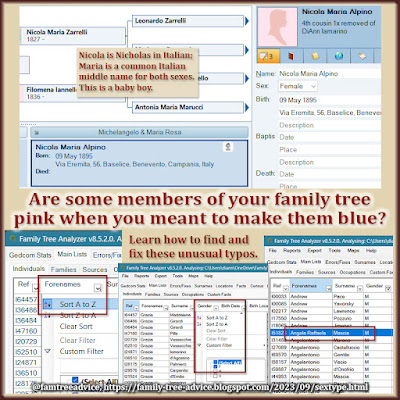Don't miss the May 2025 companion to this article, "Key Facts on Your Ancestor's Italian Military Record".
In 2018 I walked into the state archives building in Benevento, Italy. I armed myself with a couple of sentences in Italian stating what I wanted. I had the exact book and record number for my grandfather's military record, and that's what I wanted to see.
This was the highlight of that particular trip to Italy. A woman brought me to a big room filled with tables and chairs. She asked me to fill out a request form for the record. While I filled out the form, my back to the room, someone brought in the book and placed it on a table.
The woman then pointed me to the book. I was ecstatic! I quickly turned to the right page and scanned the details. I found exactly what I'd hoped to find: the name of the prisoner-of-war camp where the enemy held him for a year. In my previous research, I narrowed down the possible camps to two places in Austria. One of them was correct! They held him at Mauthausen in northern Austria, a long way from the fighting near the Italian border.
The Italian prisoners from World War I were largely starved to death. My grandfather once mentioned eating rats to survive. A larger version of Mauthausen also served as a concentration camp in World War II. Seeing the 2018 movie "The Photographer of Mauthausen" left me shaken and sobbing knowing my grandfather had been there earlier.
At the archives in 2018, I took photos of my grandfather's detailed military record to study later. While I was doing this, a young man brought me another book. It was the 1891 birth register, which he'd opened to my grandfather's record. I'd seen this image online, but seeing it in person made me very emotional. The size of the book was quite a surprise. We see these little images online and try to make out the small handwriting. But the book was huge! I would guess it was 15 inches wide and 25 inches high.
You have two main choices for viewing your relative's Italian military record. You can visit the archives in Italy or find the record online. Don't expect the record to be online if your relative lived through the war. But you can still find useful information.
 |
| Your Italian ancestor's military record holds a tremendous amount of details. |
Method 1. Visit the Archives
This isn't an option for everyone, I know. But if you do get to visit Italy, you'll need to go to the appropriate provincial archives. My ancestors all came from either the Benevento province or the Avellino province. If you know your ancestor's hometown, look it up to see which province contains their town. To find the address of your provincial archives, go to the Antenati website and click your province name. You'll find a map and a link to the archive's website for more information.
Another option is to search Google for one of these phrases, filling in the blank with the province name you want. The quotation marks will help you get better results.
- "indice onomastico di ____"
- "ruoli matricolari di ____"
- "liste di leva di ____"
You'll have an easier time getting your ancestor's military record if you know their book and record number plus the year they were born. This makes it very easy for a worker at the archives to retrieve the right book of records.
Check your province's archives website for a link called "Ruoli matricolari" or "Indice onomastico" or "Liste di leva". Many of the archives websites don't have this information, but you're sure to find something of interest. If you can't find military record information, be sure to see Method 2 in this article and the Resource List.
On the Benevento archives website it's easy to enter your ancestor's last name (cognome), first name (nome), town of birth (Luogo di nascita), and year of birth (classe). The fields are not all required.
When I search for my grandfather (Leone, Adamo, Baselice, 1891), the results screen includes two new bits of information:
- Registro 67 (book number 67)
- Matricola 21728 (record number 21728)
I gave these numbers and my grandfather's name and birth year to a clerk at the Archivio di Stato di Benevento.
If you can't find your person's book and record number online, it will be helpful to have their full name, hometown and year of birth.
Method 2. Find the Record Online
On the Benevento website it's easy to enter your ancestor's last name (cognome), first name (nome), town of birth (Luogo di nascita), and year of birth (classe). The fields are not all required.
To find Italian soldiers who died in World War I:
- Go to https://www.cadutigrandeguerra.it/CercaNome.aspx (The link I had here before is no longer working.)
- You don't have to fill in all the fields. I recommend putting that URL into Google Translate so you can see what's required. Click the CERCA button and give it a try.
When I enter my maiden name of Iamarino in the box, I find that only one man with that name, Alfonso Iamarino, died in the war. The search result tells me Alfonso's date and town of birth, and his father's first name. There's a blue button next to the results that says Apri (open). Clicking that shows only a brief listing about the soldier. Here's what it tells me about Alfonso Iamarino:
- Alfonso Iamarino is the son of Pasquale.
- He served as a soldier in the 156th infantry.
- He was born on 15 Feb 1892 in Colle Sannita.
- He died on 10 Apr 1917 in Mira (near Venice) of illness.
That's a lot of information from a two-line entry on a page in a book. Since Alfonso came from Benevento, I can search for him on the Ricerca caduti (search for fallen soldiers) page of the archives website. The results page gives me only a little more information:
- That he died in a military hospital.
- The book and record numbers for his military record.
But there's also a link to a PDF, and this is the military record itself!
The military record has his mother's full maiden name and his detailed physical description. In the main body of the page there's a list of dates and a description of what happened. Some examples:
- On 9 Sep 1912, Alfonso answered the call to arms (chiamato alle armi); on the 19th he joined the 42nd infantry regiment.
- He got his younger brother Carmine to take his place, delaying his own service.
- On 15 Jan 1915, Italy was in a state of war, and Alfonso could no longer delay his service.
- On 1 Jun 1916, he joined the 156th infantry regiment.
- On 10 Apr 1917, he died of illness in a military stage hospital in Mira.
My grandfather's military record fills the page completely. He answered the call to arms many times, and there's a note that he didn't report for duty in 1914 because he was in New York. I learned from his record that:
- The Army promoted him to corporal on 1 Jan 1917.
- He became a prisoner and wound up at Mauthausen on 6 Nov 1917.
- They freed him on 6 Nov 1918 (a whole year!).
- The Italian Army gave him unlimited leave on 21 Aug 1919.
- He returned to New York on 2 Apr 1920. (Lucky for me.)
Military service was mandatory starting in 1865 for Italian men beginning at age 20. (This wasn't abolished until 2005.) The lack of any record for my grandfather's brother leads me to believe he died in his teens. Some day I hope his death record will be available.
Resource List
I don't know if any of the provincial archives websites are as useful as Benevento. (Again, lucky for me.) But here are several great resources for you to try. If you put these URLs into Google Translate, you can see a translated version of the page. Sometimes these Italian websites are unreachable. If that happens to you, try again later.
- Italian World War I casualty search form (don't worry—not many fields are required): https://www.cadutigrandeguerra.it/CercaNome.aspx
- Italian World War I casualty search form (a last-name-only form): https://www.difesa.it/Il_Ministro/CadutiInGuerra/Pagine/AlbodOro.aspx
- Italian World War II casualties by province (scroll down to list of provincia): https://dimenticatidistato.wordpress.com/elenco-nazionale-caduti-per-comune-di-nascita
- Links to all provincial archives for more information: https://antenati.cultura.gov.it/esplora-gli-archivi
- Lists of soldiers from the Alessandria province born between 1913 and 1939 with their record numbers: http://www.archiviodistatoalessandria.beniculturali.it/index.php?it/247/distretto-militare-di-alessandria-con-casale-e-tortona
- Italian soldiers from the Benevento province who died in World War I: https://asbn.cultura.gov.it/caduti-grande-guerra
- Basic details on every soldier from the Benevento province, born between 1869 and 1932: https://asbn.cultura.gov.it/ruoli-matricolari
- Lists of soldiers from the Gorizia province with their book and record numbers: https://archiviodistatogorizia.cultura.gov.it/ruoli-matricolari
- Lists of soldiers from the Salerno province with their book and record numbers: https://assa.beniculturali.it/vistadb/listeleva.php
- Lists of soldiers from the Siracusa province: https://archiviodistatosiracusa.cultura.gov.it/patrimonio/documentazione-militare
Let me know if you find any other Italian military record resources to add to this list. I find it very helpful to be able to learn what became of some young men from my ancestral towns. Many had wives and small children when they died. At least now I know what happened.

